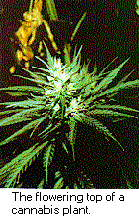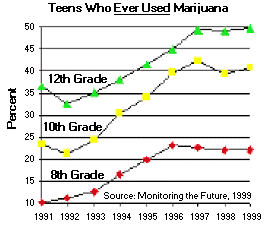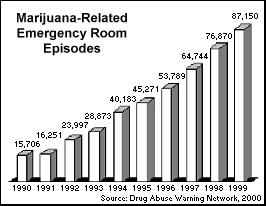 |
 |
|
| Home | Chi siamo | Convegni | News & Comunicazioni | Pubblicazioni | Newsletter | Video Gallery | ||
   
|
||

|
||
MARIJUANAPharmacology
Although marijuana grown in the United States was once considered inferior
because of its low concentration of THC, advancements in plant selection and
cultivation have resulted in highly potent domestic marijuana. For example,
the average THC content of U.S.-produced sinsemilla has risen from 3.2 percent
in 1977 to 12.8 percent in 1997. Marijuana contains known toxins and cancer-causing chemicals that are stored
in fat cells of users for up to several months. Marijuana users experience
the same health problems as tobacco smokers, such as bronchitis, emphysema,
and bronchial asthma. Some of the effects of marijuana use also include increased
heart rate, dryness of the mouth, reddening of the eyes, impaired motor skills
and concentration, and frequent hunger. Extended use increases risk to the
lungs and reproductive system, as well as suppression of the immune system.
Occasionally, hallucinations, fantasies, and paranoia are reported. UseOverall usage: The number of marijuana-related
emergency room episodes, which are tracked by the Drug Abuse Warning Network
(DAWN), has steadily increased from 15,706 in 1990, to 87,150 in 1999.
Many of these visits can be attributed to the fact that the potency of marijuana
has also increased during that same time period. The 1999 National Household
Survey on Drug Abuse (NHSDA) estimated that 5.1 percent (11.2
million) of the population aged twelve and older were monthly marijuana or
hashish users, which is the same rate as in 1991 but considerably lower than
the rate of 13.2 percent in 1979. NHSDA also found that the number
of first-time marijuana users in 1998 (2.3million) increased significantly
compared to 1989 (1.4million). In addition, according to the Office of
National Drug Control Policy's 1998 Drug Control Strategy, marijuana
is the most prevalent illegal drug in the United States; approximately three-quarters
(77percent) of current illegal drug users used marijuana or hashish in 1996.
Use among youth: The marijuana problem among youth
is particularly acute. According to a survey conducted by Phoenix House, an
organization that runs drug abuse treatment centers and conducts extensive
research, marijuana was the drug of choice for 87 percent of teens entering
treatment programs in New York during the first quarter of 1999. A 1996 national
survey conducted by Phoenix House revealed that eighty-three percent of adolescents
in treatment perceived, at one time or another, marijuana to be less dangerous
than other illicit drugs, and 60 percent agreed that using marijuana made
it easier for them to consume other drugs, including cocaine, methamphetamine,
and LSD. Similar statistics were found by the 1999 Monitoring the Future
study, which showed that marijuana is the illegal drug most frequently
used by young people. Among high school seniors, 49.7 percent reported using
marijuana at least once in their lives. By comparison, that figure was 41.7
percent for seniors in 1995 and 32.6 percent in 1992. The 1999 NHSDA found
that nearly one in 13 youths aged 12-17 were current users of marijuana in
1999 and that the prevalence of marijuana use among youth more than doubled
from 1992 to 1999. The 1998 National Center on Addiction and Substance
Abuse study indicates that adolescents are first exposed and try marijuana
at a very young age. According to the study, 50 percent of 13-year-olds reported
that they could find and purchase marijuana, and 49 percent of teens surveyed
said that they first tried marijuana at age 13 or younger. AvailabilityAvailability: Marijuana is readily available throughout
all metropolitan, suburban, and rural areas of the continental United States.
Sources
A trend toward indoor marijuana production in the United States is largely due to successful drug law enforcement efforts to curtail outdoor cultivation. Moreover, indoor growing provides a controlled environment conducive to the production of highpotency sinsemilla. Indoor cultivation permits yearround production and can be accomplished in a variety of settings. Indoor grows range from several plants grown in a closet, to thousands of plants grown in elaborate, specially constructed greenhouses. Rates of vegetation, growth, and maturation are enhanced by special fertilizers, plant hormones, steroids, insecticides, and genetic engineering. In 1998, the five leading states for indoor growing activity were California, Florida, Oregon, Alaska, and Kentucky. Indoor growers cultivated 89 plants on average. Nationwide in the same year, drug law enforcement authorities seized 2,616 indoor grow operations.
TraffickingVirtually all marijuana is smuggled into the United States concealed in false
compartments, fuel tanks, seats, and tires of private and commercial vehicles,
pickup trucks, vans, mobile homes, and horse trailers. Larger shipments, up
to multi-thousand kilogram amounts, usually are smuggled in tractor-trailer
trucks in false compartments and among legitimate bulk shipments, such as
agricultural products. U.S. authorities seized a record 593 metric tons of
marijuana along the Southwest Border in 1997 - approximately 25 percent more
than that seized in 1996 and nearly double that seized in 1995. With increased
law enforcement pressure along the Southwest Border of the United States,
marijuana smugglers are shifting to traditional routes in the Gulf of Mexico
and the Bahamas. They use cargo vessels, pleasure boats, and fishing boats
to sail up the coast of Mexico, either to U.S. ports or drop-off sites along
the U.S. coast and the Bahamas.
|
| Primo Piano Dipartimento Politiche Antidroga |
|
| Vocabolari | |
|
- Alcohol and drug terms - WHO |
|
| Oggi i giornali parlano di droga | |
Home | FAQ's | Site Map | Credits | Help | Informativa sull'utiizzo dei cookie | RSS  |
| N N D Network Nazionale sulle Dipendenze |







